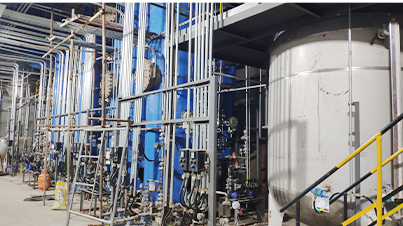phosphorothioate
Phosphorothioate A Gateway to Novel Therapeutic Applications
Phosphorothioates are an intriguing class of chemical compounds that have garnered significant attention in the fields of medicinal chemistry and molecular biology. Distinguished by their unique phosphorus-sulfur bonding, phosphorothioates possess remarkable properties that enable them to play pivotal roles in the design of oligonucleotide-based therapeutics and innovative research tools.
Chemical Structure and Properties
Phosphorothioates are characterized by a phosphorus atom bonded to three oxygen atoms and one sulfur atom, in place of one oxygen in the typical phosphate group. This modification imparts several important properties to phosphorothioate compounds, notably increased stability against nucleases - enzymes that degrade nucleic acids. The presence of sulfur enhances the binding affinity of these compounds to complementary nucleic acid sequences, thereby optimizing their efficacy as therapeutic agents.
Therapeutic Applications
The enhanced stability and binding properties of phosphorothioates render them exceptionally useful in the realm of antisense oligonucleotide (ASO) therapy. ASOs are short, synthetic strands of nucleic acids designed to bind to specific RNA targets, leading to the modulation of gene expression. By incorporating phosphorothioate modifications into ASOs, researchers have developed potent therapies for a range of genetic disorders, including spinal muscular atrophy and certain forms of muscular dystrophy.
For instance, the FDA-approved drug Nusinersen (brand name Spinraza) utilizes phosphorothioate chemistry to effectively treat spinal muscular atrophy by increasing the production of the survival motor neuron (SMN) protein. By targeting the splicing of the SMN2 gene, phosphorothioates demonstrate the potential to alleviate symptoms associated with this debilitating condition, highlighting their significance in the development of precision medicine.
Moreover, phosphorothioates have found applications in antiviral therapies. The emergence of RNA viruses has prompted the need for novel therapeutic strategies, and phosphorothioate-modified RNA molecules can act as potent inhibitors by targeting viral RNA, thereby disrupting the viral life cycle. This approach has shown promise in studies targeting viruses such as HIV and influenza, paving the way for new antiviral drug candidates.
phosphorothioate

Research and Diagnostic Tools
Beyond therapeutic applications, phosphorothioates are also invaluable in research and diagnostic settings. Their resistance to enzymatic degradation allows for the development of robust probes and primers useful in various molecular biology techniques, such as PCR (Polymerase Chain Reaction) and FISH (Fluorescence In Situ Hybridization). Researchers can employ phosphorothioate-modified oligonucleotides to enhance the sensitivity and specificity of diagnostic assays, enabling earlier and more accurate detection of genetic diseases and pathogens.
Furthermore, phosphorothioate modifications can be leveraged to investigate gene function and regulation. By using phosphorothioate-containing oligonucleotides as antisense agents, scientists can selectively inhibit the expression of target genes, thus providing valuable insights into gene networks and pathways. This application is particularly crucial in understanding complex biological processes and disease mechanisms.
Safety and Ethical Considerations
While the potential of phosphorothioates is vast, it is imperative to address safety and ethical considerations associated with their use. The introduction of any new therapeutic agent raises questions regarding toxicity, bioavailability, and long-term effects. It is crucial for researchers to conduct comprehensive studies to evaluate the safety profiles of phosphorothioate-based therapies, ensuring they do not elicit unwanted immune responses or accumulation within the body.
Additionally, the ethical implications of manipulating gene expression through ASO technology must be thoughtfully contemplated. As with any advanced therapeutic technique, the potential for misuse or unintentional consequences necessitates the establishment of rigorous regulatory frameworks to guide research and clinical applications.
Conclusion
In conclusion, phosphorothioates stand at the forefront of molecular therapeutics and research innovation. Their unique chemical properties enable a myriad of applications ranging from gene modulation therapies to diagnostic tools. Continued exploration of phosphorothioate chemistry holds promise for the development of novel treatments for genetic disorders, infectious diseases, and beyond. As we advance our understanding of these compounds, the potential to transform medicine and improve patient outcomes becomes increasingly tangible. The field of phosphorothioates is one that deserves sustained focus and investment, as it may unlock new avenues for therapeutic interventions that enhance human health in meaningful ways.
-
Premium Isothiazolinones | Broad-Spectrum Biocidal SolutionsNewsAug.28,2025
-
LK-319 Special Scale And Corrosion Inhibitor For Steel Plants: Advanced Solutions for Industrial Water SystemsNewsAug.22,2025
-
Flocculant Water Treatment: Essential Chemical Solutions for Purification ProcessesNewsAug.22,2025
-
Isothiazolinones: Versatile Microbial Control Agents for Industrial and Consumer ApplicationsNewsAug.22,2025
-
Scale Inhibitor: Key Solutions for Water System Scale PreventionNewsAug.22,2025
-
Organophosphonates: Versatile Scale Inhibitors for Industrial Water SystemsNewsAug.22,2025





